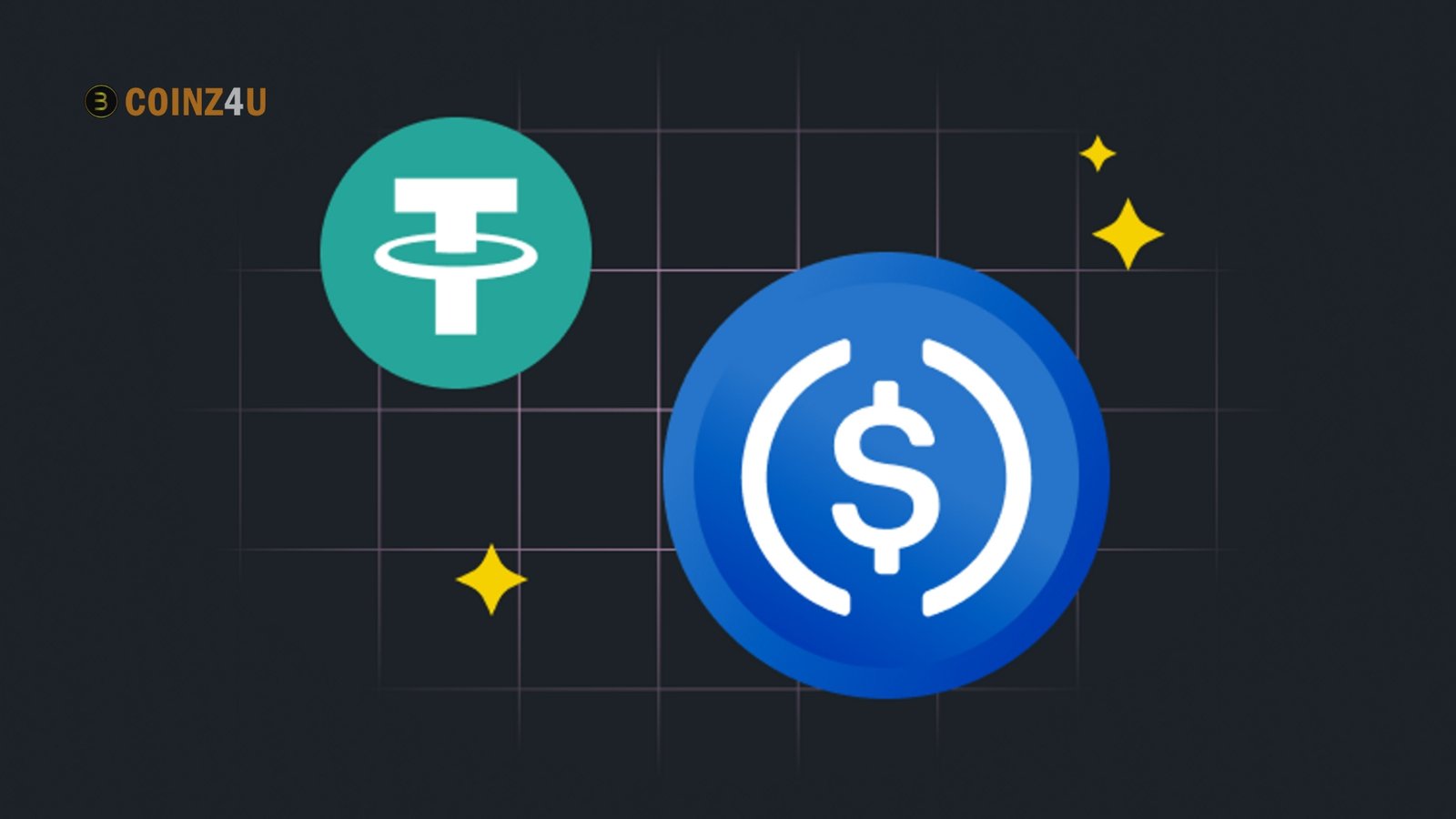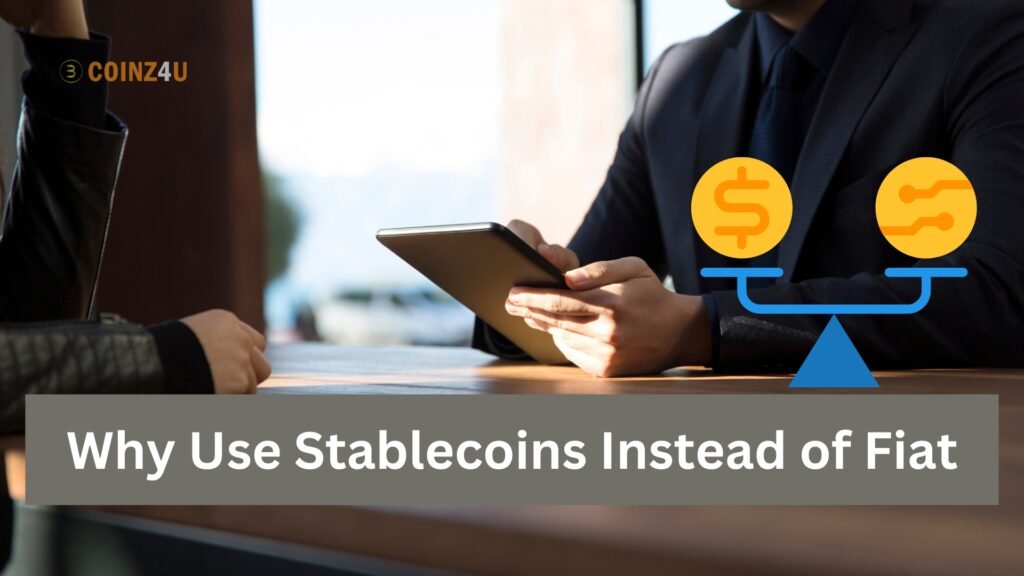There have been discussions on the future of money in the ever-changing world of finance, thanks to blockchain technology and cryptocurrencies. Stablecoins are one of the most notable developments in this space; they provide an alternative to fiat currencies such as the US dollar and the euro. So, why would anyone think about utilizing stablecoins instead of fiat currency, and what are their compelling features? Stablecoins have many practical benefits over fiat currencies, which this article will discuss. These include their accessibility, stability, and capacity to integrate with digital ecosystems.
Stablecoins are a special kind of cryptocurrency that aims to keep their value constant by linking them to something else: a commodity like gold or a fiat currency like the US dollar. Stablecoins strive to provide steadiness, making them more suited for everyday transactions and as a store of wealth, unlike other cryptocurrencies like Ethereum and Bitcoin, which can undergo substantial price volatility.
Popular stablecoins include:
- Tether (USDT): Pegged to the US dollar
- USD Coin (USDC): Another USD-pegged stablecoin
- Dai (DAI): Pegged to the US dollar but decentralized and backed by collateralized assets
- Binance USD (BUSD): Pegged to the US dollar and issued by Binance
These stablecoins provide price stability inside the larger cryptocurrency framework, fusing traditional banking with blockchain technology to create a hybrid financial model.
Why Consider Stablecoins Over Fiat?

Borderless Transactions
The capacity to send and receive funds internationally without intermediaries like banks is a major perk of utilizing stablecoins instead of fiat. Time lags, hefty fees and convoluted currency conversion procedures are commonplace with fiat transactions when sending money abroad. By doing away with these problems, stablecoins make cheap, near-instantaneous transactions possible.
Stablecoins can make international payments much easier for people and companies doing business on a global scale. The decentralization of stablecoins allows them to circumvent the constraints imposed by national financial institutions. Stablecoin transfers are instantaneous and global, so there’s no need to worry about currency conversions or processing delays.
Reduced Transaction Costs
Transfers, particularly those involving funds from another country, incur fees when processed through conventional banking systems and payment processors such as PayPal or credit cards. The percentage of the transferred funds these fees take can be small or large. Compared to more conventional monetary systems, stablecoins typically have very low transaction fees.
Freelancers, remote workers, and companies with clients worldwide will find this feature especially helpful. Stablecoins allow them to circumvent the high transaction costs levied by conventional payment processors, allowing them to keep more of their earnings.
Financial Inclusion
Thanks to stablecoins, the world’s underbanked and unbanked masses may soon have access to financial services. The World Bank estimates that 1.7% of the world’s adult population has no bank account. For these people, stablecoins provide a safe and convenient alternative to traditional banking systems for digital money storage and transfers.
Stablecoins are a haven for people in areas where banks are scarce or where the currency is volatile. By storing their wealth in stablecoins, individuals can hedge against the devaluation of their home currency while still participating in the global economy.
Protection Against Inflation
Even at very high levels, inflation affects fiat currencies in many nations. For instance, due to hyperinflation, citizens may find their savings and income much less valuable. One way to protect oneself from inflation is to invest in stablecoins, particularly those linked to more powerful currencies such as the US dollar.
In nations like Zimbabwe and Venezuela, where inflation rates are in the thousands, stablecoins provide a haven. The value of people’s money can be protected from inflation by turning it into stablecoins instead of their local currency.
Transparency and Security
Stablecoins are built on blockchain technology, which provides an advantage over traditional fiat systems in terms of security and transparency. An immutable ledger records every transaction, so there is a clear and verifiable record of every transfer. All transactions are visible and can be verified by anybody, which decreases the chance of fraud.
On the other hand, the central banks and governments that underpin fiat currencies aren’t always forthcoming with information about how they use the money. Banks are usually safe but can be victims of data breaches, political meddling, or bank failures. Instead of depending on intermediaries, users of stablecoins keep full ownership of their assets.
Integration with Decentralized Finance (DeFi)

In the ever-expanding Decentralized Finance (DeFi) arena, stablecoins are indispensable. To circumvent the need for conventional banks, DeFi apps provide various banking services, including lending, borrowing, and interest income. Engaging with these platforms using stablecoins is possible, as they are the backbone of numerous DeFi protocols.
One example is the DeFi platform, where users can lend their stablecoins to others and earn interest or even use them as collateral for a loan. These alternatives offer financial independence and freedom frequently absent from conventional banking institutions.
24/7 Accessibility
Stablecoins function on blockchain networks that are available at all times, unlike traditional banks that have set hours of operation and are closed on holidays and weekends. Thanks to its round-the-clock accessibility, customers no longer worry about missing out on important financial transactions because they can’t wait for bank hours to finish.
Stablecoins offer unparalleled convenience for individuals and organizations who want access to their cash or make transactions at odd hours. Stablecoins remove the limitations imposed by bank operating hours on various financial transactions, including international money transfers, service payments, and DeFi market participation.
Programmability and Smart Contracts
The fact that stablecoins can be programmed makes them ideal for use in smart contracts, which is another perk. The phrases of an agreement can be codified into code and then executed automatically by a smart contract. Ideal for financial operations, such as payments and corporate agreements, these contracts can automate transactions based on established parameters.
For instance, if you own an online shop, you can incorporate stablecoins into a smart contract to trigger automatic payments upon fulfilling specific criteria, such as shipment confirmation. The involvement of a third party, such a bank or payment processor, is eliminated, and manual intervention is minimized, as a result.
Conclusion
Stablecoins provide an attractive alternative to fiat currencies in the modern digital era, historically supporting international finance. Stablecoins integrate DeFi with the efficiency and security of blockchain technology, allowing for borderless transactions, decreased costs, protection against inflation, and other improvements to ordinary financial activity.
The versatility, openness, and inclusivity of stablecoins may surprise many people and companies as they learn more about these digital assets. Although stablecoins may come with some dangers, they are a great tool for anyone trying to get in on the global economy because of how they adapt to the changing financial scene.
Also Read: Altcoins vs Stablecoins: Significant Differences Stated
[sp_easyaccordion id=”3254″]


